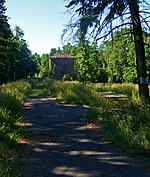High Falls, New York
Census-designated places in New York (state)Census-designated places in Ulster County, New YorkHamlets in New York (state)Hamlets in Ulster County, New YorkRosendale, New York ... and 1 more
Use mdy dates from July 2023

High Falls is a hamlet (and census-designated place) in Ulster County, New York, United States. The population was 700 at the 2020 census. Portions of High Falls are located in the towns of Marbletown, Rosendale, and Rochester.
Excerpt from the Wikipedia article High Falls, New York (License: CC BY-SA 3.0, Authors, Images).High Falls, New York
State Highway 213,
Geographical coordinates (GPS) Address Nearby Places Show on map
Geographical coordinates (GPS)
| Latitude | Longitude |
|---|---|
| N 41.826944444444 ° | E -74.122222222222 ° |
Address
State Highway 213 1066
12440
New York, United States
Open on Google Maps










